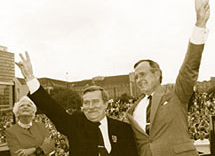End to the Cold War
When Bush became president, the Soviet empire was on the verge of collapse. Gorbachev's efforts to open up the USSR's economy appeared to be floundering. In 1989, the Communist governments in one Eastern European country after another simply collapsed, after it became clear that Russian troops would not be sent to prop them up. In mid-1991, hard-liners attempted a coup d'etat, only to be foiled by Gorbachev rival Boris Yeltsin, president of the Russian republic. At the end of that year, Yeltsin, now dominant, forced the dissolution of the Soviet Union.

President George H.W. Bush with Poland's Lech Walesa (center) and First Lady Barbara Bush in Warsaw, July 1989. That remarkable year saw the end of the Cold War, as well as the end to the 40-year division of Europe into hostile East and West blocs.
(David Valdez/The White House)
The Bush administration adeptly brokered the end of the Cold War, working closely with Gorbachev and Yeltsin. It led the negotiations that brought the unification of East and West Germany (September 1990), agreement on large arms reductions in Europe (November 1990), and large cuts in nuclear arsenals (July 1991). After the liquidation of the Soviet Union, the United States and the new Russian Federation agreed to phase out all multiple-warhead missiles over a 10-year period.
The disposal of nuclear materials and the ever-present concerns of nuclear proliferation now superseded the threat of nuclear conflict between Washington and Moscow.
